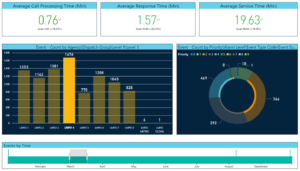Ambulance service providers are under intense public scrutiny. When citizens report an emergency, they expect a professional response as quickly as possible. Because every second counts, control center dispatchers and ambulance units are under pressure to respond instantly.
Additionally, many EMS control centers not only dispatch their own rescue units, but also act as service providers for various, sometimes private, ambulance service organizations, such as hospitals. Because they pay money for this service, these organizations expect high quality in return. As a result, competition plays a role in control center performance.
Accessing real-time control center insights
Depending on location, regulations and benchmarks set the bar for appropriate operational effectiveness and how it’s measured. These are often set by EMS agencies, umbrella associations, governments, and health insurance companies.
For the control center, this means setting threshold values for maximum emergency call pickup times and maximum time to dispatch. To monitor these values, the head of the control center must have access to real-time information about current capacity. They continually need answers to questions like:
- How many calls have we had?
- What is the average pickup time?
- Have we had calls that exceeded the given threshold values?
Reliable reports on dispatcher workload and control center occupancy – both live and in the past – are essential to account for overall control center performance and future personnel and shift planning, particularly if additional resources are required.
Leveraging data for long-term optimization
Control centers can take advantage of data insights beyond general performance indicators. For example, reanimations are often permanently accompanied by the call-taker until the ambulance unit arrives, which can completely absorb the call-taker. Proactively considering factors like this enables more refined shift and capacity planning.
Cross-referencing call-taker and dispatcher response times with the type of emergencies they must handle could indicate optimization potential in the dispatching process or the system. Also, evaluating individual call-taker and dispatcher performance indicators allows for identifying training potential.
How can you find this data?

To achieve these insights, EMS agencies must have access to reliable, complete, and aggregated dispatch data. HxGN OnCall Analytics provides a data warehouse and a number of out-of-the-box reports that help agencies mine data and find areas for control center optimization. As opposed to paginated reports, the interactive dashboards with multiple layers of information empower users to intuitively dig into the data and look for trends, patterns, and insights.
The solution’s web-based user interface provides easy, wide access to this information, allowing all users to access what they need and easily run reports, turning fragmented data into actionable insights.
Next steps
For more information about how your EMS organization can harness data to optimize your control center, visit the HxGN OnCall Analytics product page.















